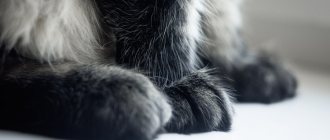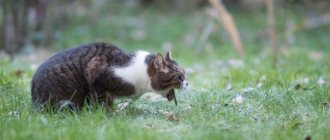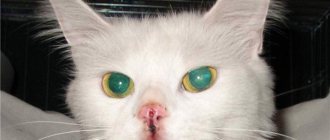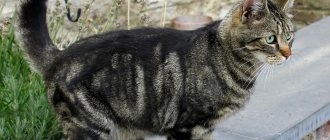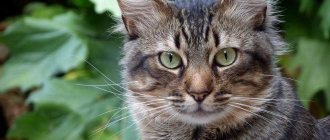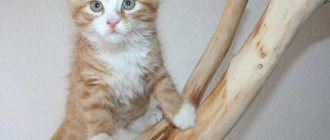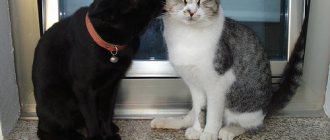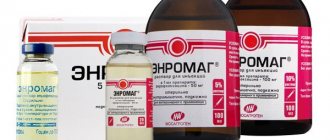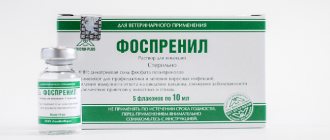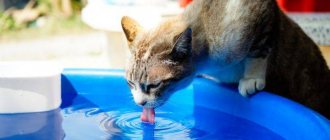Owners of mustachioed pets often encounter damage to furniture. The thing is that at home, a cat’s claws practically do not wear down naturally. Because of this, any available materials are used.
The most drastic way to eliminate the problem is declawing surgery, but such an intervention has many disadvantages. Such an impulsive decision will definitely affect your pet's quality of life, so you should choose safer alternatives instead.
Number of claws
First, let's figure out how many claws a cat has. Despite the number of limbs, there are not 20, but only 18.
How many claws does a cat have on its front paws?
Understanding how many claws a cat has on its front paws is very simple. You need to pick up your pet and carefully examine it. As we explore, it will become clear that at least here we are similar.
At the base of the cat's front foot there are 4 toes, and a little further away there is another additional one, similar to ours, the big one. The claw on this finger makes it easier to grasp objects.
How many claws does a cat have on its hind legs?
You might be surprised to find out how many claws cats have on their hind legs. There are only 4 fingers here. Thus, the total number really is exactly 18.
Deviations from the norm
Cats, like people, have deviations from the norm. For the animal itself, a different number of toes on the paws does not pose any problems and does not affect the quality of life in any way. On the contrary, it gives a good advantage over its peers if there is an “extra” finger, or polydactyly.
There are two types of polydactyly:
- postaxial - the toes grow in a row with the main ones, as a result the paw resembles a snowshoe;
With postaxial polydactyly, “extra” fingers grow flush with the main ones - preaxial - the toes grow behind the fourth toe, and as a result the paw resembles a mitten.
Preaxial polydactyly is characterized by extra toes on the inside of the paw
Polydactyly is most common in the Maine Coon breed. Up to 40% of individuals have additional toes on the hind and front paws. Felinologists believe that this is due to the origin of the breed from the northeastern part of America. In winter, a lot of snow falls there, and it is much more convenient for polydacts to move through the snowdrifts (the “snowshoe” paws do not sink deep).
Video: Maine Coon kitten - polydact
In my opinion, it is in Maine Coons that polydactyly looks especially cute. After all, their paws are already quite large and wide. I don’t know what “extra” fingers would look like on an ordinary barn cat. In my life I have never seen anything like this.
Causes of the anomaly
The cause of this anomaly is a genetic mutation caused by an autosomal gene. This means that the mutated gene will overlap the healthy one. Therefore, if one of the kitten’s parents has polydactyly, then the baby will either be born with polydactyly or will be a carrier of the gene and pass it on to the next generation.
Who are ship cats?
Ship cats are polydactic cats. They got their name thanks to sailors who kept cats on ships to fight rodents and noticed that polydacts were much more stable on deck during a storm, unlike their brothers. Sailors were more willing to take just such animals on board, attributing to them the ability to bring good luck and protect them from troubles.
Sailors still believe that a cat on a ship brings good luck.
Interesting facts about polydacts
The polydactyl gene is strictly monitored in purebred cats. The requirements for breed standards are immutable, and polydacts are strictly excluded from breeding.
And in Belgium and Holland, a movement has been organized to revive the stock of Maine Coons with extra fingers as a separate direction of the breed, indicating its aboriginality.
It is noteworthy that polydactic cats are very popular. US President Theodore Roosevelt adored his pet polydactus named Slippers. The six-toed cat Snowball was Hemingway's favorite. By the way, now on the island of Key West, more than forty cats live in the writer’s house-museum, all of them are six-toed and are direct descendants of the writer’s pet.
The Guinness Book of Records boasts such specimens as Jake the cat (he had 28 fingers) and a cat named Tiger, the owner of 27 fingers.
Structure of a cat's claw
Cat claws are a specific type of skin, close to the human nail plate. They consist of the epidermis, the outer layer of skin containing large amounts of keratin.
This substance serves to protect soft sensitive tissues hidden in the inner part of the claws - the pulp. It is easy to spot by its pinkish tint. The pulp contains nerve fibers and choroid plexuses, so damage to this area is accompanied by acute pain and bleeding.
It's also worth noting the shape. Most whiskered pets are equipped with sickle-shaped claws, but there are exceptions. For example, the Persians have curved ones. During fights, these cats inflict more dangerous injuries on their opponents, since this shape makes it easier to get right under the skin.
Functions of a cat's claws
A cat's claws perform a number of important functions. The most important ones include the following:
- Protective. Whiskered pets use their “edged weapons” for defense against enemies and during hunting, easily tearing apart the soft tissues of caught prey.
- Depreciation. Allows you to land correctly when jumping, maintaining the integrity of your legs and spine even when falling from high floors.
- Communicative. Leaving peculiar marks is a way of marking one’s territory and warning potential rivals.
- Maintaining balance. With the help of additional support, animals can easily move along trees, window sills and various shaky surfaces.
- Muscle relaxation. Clinging to the carpet with its claws, the cat stretches its stiff and overstrained limbs.
- Facilitating the hunting process. The claws retract and extend thanks to tendon ligaments and muscle fibers. A sneaking pet removes them and silently moves towards the victim almost on its toes, without completely stepping on the foot.
The desire to scratch and grind everything around is a completely natural physiological state for all representatives of the cat family. It occurs due to periodic detachment of the stratum corneum as it grows.
Why you shouldn't declaw a cat
Onychectomy, or declawing cats, amounts to animal cruelty in several European countries. The thing is that this operation involves partial removal of the phalanx, which is accompanied by difficult long-term rehabilitation and carries very high risks for the person being operated on. The main consequences include the following:
- Formation of abscesses in internal organs. The rupture of these formations is fraught with blood poisoning.
- Acute pain syndrome. After onychectomy, the animal loses its usual activity and appetite, since the wounds take a very long and painful time to heal.
- Fall of immunity. Due to constant stress, the immune response is reduced, leading to more frequent and more severe illnesses.
- Impaired musculoskeletal function. Along with the claws, the former grace is lost, which negatively affects the spine. Also, due to loss of coordination, the number of injuries increases.
- Losing a tool for self-defense. Meeting other animals on a street walk can result in very serious consequences, since the cat has nothing else to protect itself with. If he gets lost, the chances of finding him alive are close to zero.
- There is a high probability of developing osteomyelitis - purulent-necrotic inflammation that destroys bones.
- Heavy bleeding. The animal may die due to excessive blood loss not only during surgery, but during the rehabilitation period.
- Mental change. Loss of a sense of security increases aggression, so the operated pet often attacks its owners. He becomes alienated and withdrawn due to constant fear.
- Regularly relieving yourself in the wrong place. Raking excrement with injured paws causes severe pain, so any cat litter causes severe rejection. For this reason, the cat chooses secluded corners with a soft surface.
- Various diseases of internal organs. Low activity is the main reason for weight gain, so pathologies of the cardiovascular system and gastrointestinal tract develop along with obesity.
Despite the huge number of disadvantages, there are exceptions when onychectomy is truly necessary. This radical method of treatment is resorted to when affected by a cancerous tumor progressing in the claw area.
The principle of dermatitis
Dermatitis occurs for various reasons:
- thermal reasons. This disease occurs when a cat's skin comes into contact with a hot object or liquid. Prolonged exposure to sun rays or low temperatures on areas of the body can also lead to thermal dermatitis;
- parasitic causes - bites of fleas, ticks, lice eaters. The saliva released when bitten by such an insect causes severe itching. In addition, these parasites constantly shed scales, hairs, and secrete waste products - all this causes a rash and skin irritation. This type of inflammation usually appears behind the ears and in the tail area;
If an animal is bitten by an ixodid tick, then swelling occurs at this site. A tick bite causes skin itching and inflammation. Then a bald spot and a rash forms. Subcutaneous parasites cause extensive rashes and blisters. If a cat's ears are affected, then dermatitis manifests itself in the form of redness and rash in the ears. Helminths provoke dermatitis by entering the animal’s body and multiplying in its intestines. They release toxic substances and waste products. In the presence of parasitic dermatitis, the cat literally tears its skin with its paws and teeth, trying to get rid of severe itching. By scratching wounds, an animal can introduce an infection there.
irritants. Due to its increased sensitivity, a cat can react to contact with an external irritant. For example, domestic cats react to new shampoo, cleaning chemicals, and new items in the apartment. Dermatitis of the oral mucosa is possible after a pet comes into contact with poisonous house plants.
When the animal's immunity decreases, dermatitis occurs as a reaction to bacteria or fungus that could live on the cat's skin for a long time before. A favorable environment for fungal growth is warmth and humidity. Therefore, most often it occurs in the folds, in the armpits, on the chin, between the fingers, in the groin and tail.
Important! Flat-faced Persian cats are most susceptible to bacterial dermatitis. They usually develop fungus in the nose area
Such dermatitis usually does not have an obvious form, sometimes becoming more pronounced, sometimes going into hibernation.
How to deal with a cat scratching furniture and wallpaper
Declawing a cat is not an option. The consequences of such an operation do not at all justify the damage to your favorite furniture and repairs. If you care about your pet, choose one or several of the alternatives suggested below.
scratching post
Love for a scratching post does not appear immediately. Many pets are more delighted only by the packaging box, but thanks to the due persistence of the owners, over time they get used to its contents.
In addition to regular training and timely encouragement to sharpen claws in the right place, it is necessary to take into account the wishes of the animal itself. Not everyone likes standard vertical surfaces in the form of a column and a play complex, so don’t rush to give up until you’ve tried all the possible options.
Manicure
The easiest option is to trim the cat's claws. If you follow the basic recommendations, this procedure is not dangerous and painless.
Anti-scratch
Anti-scratch caps are soft vinyl or silicone caps that are placed on the claws and replaced as they grow. Despite the convenience, this product has several disadvantages.
Under the caps, a secretion produced by the glands on the fingertips accumulates, which is fraught with inflammation. Also, some overly active cats tear off the “anti-scratch” with their teeth and swallow them.
Alternative to a haircut: is there one?
Most veterinary clinics offer the procedure - onychectomy, but how humane it is has long been discussed and condemned not only by doctors, but also by breeders who previously agreed to perform the operation on a cat. Onychectomy is nicely called “soft paws”, but in reality it is a complex, bloody and unreasonably difficult psychological procedure.
The second most popular are anti-scratch silicone tips of different colors. They are attached with special glue. A cat's manicure looks glamorous; the animal stops sharpening its claws on furniture, but this greatly affects their ability to climb and walk. In addition, multi-colored caps do not eliminate the problem - the claws underneath them still grow and need to be trimmed periodically.
Specialists of the RosVet VC do not approve of onychectomy as a whim of the owner. The operation is possible only according to indications, when there is severe injury to the fingers and it is impossible to save the phalanx. Caps are a less dangerous method, but also suppress the cat's natural instincts. The solution is to provide your pet with a place to grind down its claws or regularly visit the veterinary clinic to have its claws trimmed. You can sign up for the procedure by phone: + 7 (495) 256-11-11, around the clock.
How to care for a cat's claws
Cats are taught to trim their claws from an early age. Up to six months, babies simply have their paws examined periodically. Their fingers are still very fragile, so they can be accidentally injured.
It is recommended that the very first haircut be carried out in a veterinary clinic or grooming salon. In them you can ask in detail about the procedure and observe it from the outside.
How many times a month should you trim a cat's claws?
The frequency of haircuts varies from person to person. It depends on the speed of regrowth. Some pets need a manicure every 1.5-2 weeks, while others need a manicure only once a month.
Particular attention should be paid to those with black claws, Persian cats and sphinxes. In the former, it is difficult to find the pulp, so in their case, cutting is carried out frequently, but to the minimum possible length. “Persians” and Sphynxes are notable for increased detachment of the stratum corneum and also require more frequent procedures.
Tools
For a cat manicure, you will need a nail clipper from a veterinary pharmacy or nail clippers. It is better not to use ordinary scissors. They are more difficult to work with, so if you lack experience, you can damage your cat’s claws.
In addition to the main tool, you will need several additional ones:
- nail file to prevent splitting;
- antiseptic and cotton pads in case of emergency.
Before starting the procedure, be sure to disinfect all of the listed instruments. Otherwise, an accidental cut may cause an infection to get into the wound.
Haircut procedure
Take your pet in your arms and gently press on its paw. After releasing the claws, quickly and as confidently as possible cut off their transparent part. For reliability, it is recommended to move 2 mm away from the pulp and make a transverse section.
Note that the claws on the hind legs are shorter. The dead edge is smaller here, so the length of the cut should be shorter than on the front ones.
Problems with claws in cats and kittens
Caring for a cat's claws includes not only regular trimming, but also periodic inspection. In some cases, the animal may require the help of a veterinarian.
Foliation
Peeling off of the stratum corneum is a common physiological process that encourages cats to grind off the excess. They talk about the problem only when the claws peel too much and significantly change their appearance.
The most common causes of this disorder are improper haircut and poor nutrition. In the first case, the problem is solved by using a file, and in the second, by taking tests and adding vitamins to the diet.
Ingrown
In addition to layering, improper trimming can lead to ingrown hairs. It is also triggered by injuries.
Treatment depends on the degree of ingrowth. In case of deep damage, suppuration and the appearance of blood, it is better to immediately consult a doctor. He will perform an operation to remove the ingrown part and prescribe antibiotics and painkillers for the rehabilitation period.
Polydactyly and ectrodactyly
Another possible problem is having too many or not enough fingers. Such anatomical deviations are divided into 2 types:
- Polydactyly. If the fingers are larger than normal, then they rarely interfere with the animal, but also do not give it any advantages.
- Ectrodactyly. If the required number of fingers is missing, the situation is reversed. Such paws look like claws and interfere with full movement. There is also a risk of developing pathologies of internal organs due to the greater load on the musculoskeletal system.
Polydactyly is inherited and is completely natural in Maine Coons. The absence of an extra finger in representatives of this breed is equivalent to marriage.
In the absence of serious inconvenience, the removal of extra fingers is not encouraged. In other cases, surgery is performed at an early age, since kittens are less sensitive to pain and recover faster after amputation.
Causes of injury
A restless cat can easily damage its paw, because one incorrectly calculated jump or failed maneuver can provoke a dislocation.
Experts divide dislocations into 2 categories:
- Congenital.
- Acquired, that is, received due to injury.
Congenital dislocation occurs if the animal’s joint structure is naturally formed incorrectly; in veterinary medicine, the pathology in question, which manifests itself in kittens after 6 months, is called “dysplasia.” Most often, this disease occurs in Himalayan or Persian breeds.
Acquired injury may occur for the following reasons:
- A chronic pathology that gradually develops in an animal’s body, for example, osteoporosis or rickets, as it develops, destroys both bone and joint tissue, which can become the cause of the injury in question.
- As we noted earlier, improper handling of kittens, in particular play in which the animal is pulled by the paws, causes dislocation of both the front and back paws.
- An incorrectly calculated jump, a strong blow against any obstacle, competition with one’s relatives - all of the above actions can cause injury.
To summarize, it’s time to note that a pet’s paw can be injured almost everywhere, and only the owner can help the purr solve this problem by showing his care and love in a timely manner.
